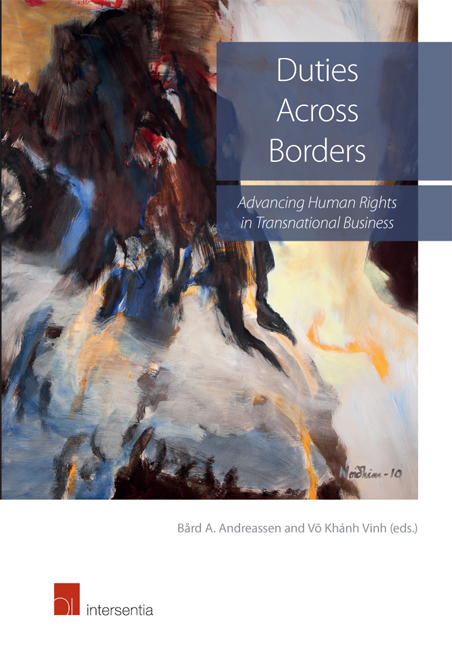Book contents
- Frontmatter
- Preface
- Contents
- List of Authors
- List of Figures and Tables
- Introduction. Business’ Duties Across Borders: The New Human Rights Frontier
- Part I. Conceptual Developments
- Part II Contextual Issues
- Chapter 7 The Next Generation of ‘Fair Trade’. A Human Rights Framework for Combating Corporate Corruption in Global Supply Chains
- Chapter 8 A Critical Analysis of Human Rights Due Diligence Frameworks for Conflict Minerals. Challenges for the Electronics Industries
- Chapter 9 The Pursuit of Substantive Corporate Human Rights Policies
- Part III Sites Of Regulation
Chapter 9 - The Pursuit of Substantive Corporate Human Rights Policies
from Part II - Contextual Issues
Published online by Cambridge University Press: 21 September 2018
- Frontmatter
- Preface
- Contents
- List of Authors
- List of Figures and Tables
- Introduction. Business’ Duties Across Borders: The New Human Rights Frontier
- Part I. Conceptual Developments
- Part II Contextual Issues
- Chapter 7 The Next Generation of ‘Fair Trade’. A Human Rights Framework for Combating Corporate Corruption in Global Supply Chains
- Chapter 8 A Critical Analysis of Human Rights Due Diligence Frameworks for Conflict Minerals. Challenges for the Electronics Industries
- Chapter 9 The Pursuit of Substantive Corporate Human Rights Policies
- Part III Sites Of Regulation
Summary
INTRODUCTION
In order to meet their responsibility to respect human rights, businesses are to create corporate human rights policies (CHRPs). The United Nations’ Guiding Principles on Business and Human Rights: Implementing the United Nations ‘Protect, Respect and Remedy’ Framework (A/HRC/17/31), establishes this much in Principles 15 and 16. However, it is unclear what makes a CHRP substantive, that is, what separates a CHRP that is just words and a policy that can improve a business’ human rights footprint? This question is salient, as is the question of what is at stake. Could a substandard or unsubstantive CHRP actually do harm? Indeed, CHRPs could act as a smoke-screen – an illusion that a business is taking human rights seriously when it is not. This chapter argues that while the UN Guiding Principles on Human Rights and Business and accompanying resources set core expectations, empirical questions remain regarding the substance and implications of CHRPs. Accordingly, a recently launched project is underway to fill the gap left by ‘no global and widely accepted process for companies to demonstrate whether their policies and processes are indeed aligned with the UN Guiding Principles and therefore capable of meeting their responsibility to respect human rights’.
There appears to be cautious optimism surrounding CHRPs, in part, because the question of substance is prominent. This cautious optimism is illustrated by Margaret Jungk, a member of the UN Working Group on Business and Human Rights, in her analysis of a proposed McDonald's shareholders’ resolution to require McDonald's to assess and publicly report on its human rights impact:
In the past, shareholder resolutions have asked companies to adopt a policy or establish a committee recognizing human rights, but haven't required companies to make sure they're implementing those policies. Nothing against policy commitments, but they're just a first step. This year's resolution asks McDonald's to go further than producing CEO-signed statements saying it will avoid negative human rights impacts.
Jungk's point highlights how meaningless an empty CHRP can be. A vague promise that a business cares about human rights is not a first step – it is a dead end. Based on a review of over 150 CHRPs, including twenty in-depth CHRP analyses, this chapter argues that the substance of a CHRP cannot be subjectively assessed; a framework with defined indicators is imperative.
- Type
- Chapter
- Information
- Duties Across BordersAdvancing Human Rights in Transnational Business, pp. 209 - 224Publisher: IntersentiaPrint publication year: 2016

